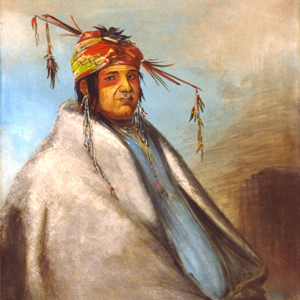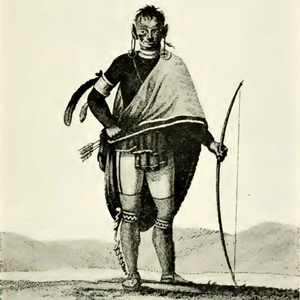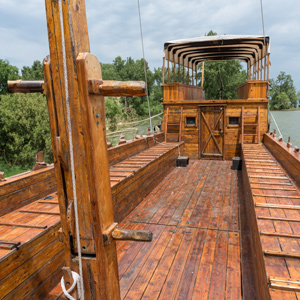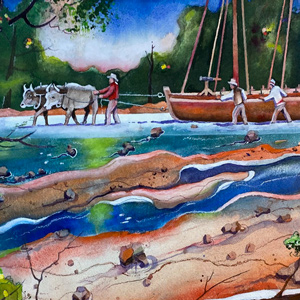© 2024 by Steve Ludeman, www.steveludemanfineart.com. Used by permission.
On 31 August 1803, after months of preparation, Lewis and his crew finally head down the Ohio River. Unfortunately, the water is so low that they must frequently unload and tow the overloaded barge with horses and oxen.
At the request of President Jefferson, Lewis disembarks at Cincinnati and travels overland to gather fossils at Big Bone Lick. He meets the boats, and together they continue to the Falls of the Ohio to pick up William Clark and several new recruits.
The expedition arrives at Fort Massac near the mouth of the Ohio on 11 November. There, they meet George Drouillard and immediately hire him as an interpreter. His first mission is to find the missing army recruits from Fort Southwest Point in Tennessee.
The Lenape Delawares
by Kristopher K. Townsend
About 1784, a small group of Shawnee and Delaware migrated from Illinois to southeastern Missouri. Ten years later, the Spanish encouraged members in Illinois to migrate the Cape Girardeau area as a way to protect their own settlements from the Osage.
The Shawnees
by Kristopher K. Townsend
As soon as the expedition boats arrived at the Mississippi River, the captains began counting Shawnee people. The Estimate of the Eastern Indians reports that 600 “Shawonies” were living on the “apple River near Cape Gerardeau.”
Synopsis Part 1
Washington City to Fort Mandan
by Harry W. Fritz
The Corps of Discovery, as it would be called, or the “corps of volunteers for North Western Discovery,” as Lewis put it, epitomized the rising glory of the United States—its sense of limitless possibilities and unparalleled opportunities.
The Barge
Barge, keelboat, or just 'the boat'?
by Joseph A. Mussulman
Meriwether Lewis listed a “Keeled Boat” in his pre-expedition shopping list, but after he finally got it, he and the other journalists of the Corps of Discovery simply called it “the boat” (190 times) or, less often, “the barge” (32 times).
Leaving Pittsburgh
A late start
by James J. Holmberg
Even though Lewis himself declared the mouth of the River Dubois to be the expedition’s official point of departure, the two and one-half months spent descending the Ohio River were in fact its real beginning.
Air Gun Accident
A shooting on Brunot's Island
by Joseph A. Mussulman
“accedentaly the ball passed through the hat of a woman about 40 yards distanc cutting her temple about the fourth of the diameter of the ball.”
Into West Virginia
The old frontier

Lewis and his skeleton crew of eleven men crossed the boundary between Pennsylvania and present-day West Virginia south of the river, and Pennsylvania and Ohio on the north. With that, they officially entered the Old Northwest.
Foggy Ohio Mornings
Weather report
by Joseph A. Mussulman
They camped for that night somewhere on the big island now known as Brown’s. When darkness fell the two canoes, which carried most of Lewis’s most valuable supplies, were still behind. “Ordered the trumpet to be sound[ed],” he wrote, “and they came up in a few minutes.”
Wheeling
"Point of Embarkation"
by Joseph A. Mussulman
Lewis had contracted with a wagoner to haul a substantial part of his baggage from Pittsburgh to Wheeling. In 1803 there were only a few thousand miles of decent wagon roads in the seventeen states, and Wheeling was the western terminus of one of the newest of them.
Cincinnati
Rest stop
by Joseph A. Mussulman
“Finding my men much fatiegued with the labour to which they have been subjected in descending the river, I determined to recruit [rest] them by giving them a short respite of a few days, having now obtained the distance of five hundred miles.”
Big Bone Lick
Collecting Fossils for Thomas Jefferson
by Earle E. Spamer, Richard M. McCourt
After leaving Pittsburgh, Lewis had his first two opportunities to personally delve into the new science of paleontology. One was a trip to Big Bone Lick, a natural salt lick and fossil bed more than 15,000 years old, situated in Kentucky less than 20 miles southwest of Cincinnati.
The Falls of the Ohio
The partnership begins
by James J. Holmberg
As the days grew shorter and cooler, William Clark must have worn a path to the Louisville landing. The barge (keelboat) could be expected to heave into site at any moment.
Louisville
Kentucky recruits
by Joseph A. Mussulman
Clark was waiting with seven more recruits who would become permanent members of the contingent soon to be known as the Corps of Volunteers for North Western Discovery.
Ohio River Recruits
by Arlen J. Large
Dearborn gave the departing Lewis an order limiting his permanent size to 15 men. These soldiers also were to be obtained at Kaskaskia and other Illinois Army posts, or newly recruited into the Army from “suitable Men” encountered by Lewis along the way.
Louisville to Fort Massac
by James J. Holmberg
Jonathan Clark mentions parting with the explorers at his son-in-law’s farm in present west Louisville, and Lewis records stopping at the first Kentucky settlement below Louisville. That settlement might have been West Point, at the mouth of Salt River, where John Shields lived.
The Wabash River
Familiar water
by Joseph A. Mussulman
Lewis, Clark, and their crew must have passed the mouth of the Wabash about 5 November 1803. The captains had crisscrossed the area in the course of their military duties, and in 1792 Clark had gained one of his first experiences in river navigation.
Fort Massac
Western headquarters
by Jo Ann Brown-Trogdon
Six years before signing on with the Lewis and Clark Expedition, George Drouillard took part in a sensitive international mission for the United States Army. This mission was probably just one of Drouillard’s many services to the United States in the last decade of the eighteenth century.
The Mouth of the Ohio
Meeting of the waters
by Joseph A. Mussulman
On the evening of 14 November 1803, Lewis and Clark camped on the point between the Ohio and Mississippi Rivers. By now they had rowed, poled, dragged, and occasionally sailed their boats a total of 981 miles.
Fort Southwest Point
Key role in planning and recruitment
by Trent Strickland
Fort Southwest Point, a frontier garrison in eastern Tennessee during the late 1790s and early 1800s, played an important role in the planning for and recruitment of soldiers for the Lewis and Clark Expedition.
Experience the Lewis and Clark Trail
The Lewis and Clark Trail Experience—our sister site at lewisandclark.travel—connects the world to people and places on the Lewis and Clark Trail.
Discover More
- The Lewis and Clark Expedition: Day by Day by Gary E. Moulton (University of Nebraska Press, 2018). The story in prose, 14 May 1804–23 September 1806.
- The Lewis and Clark Journals: An American Epic of Discovery (abridged) by Gary E. Moulton (University of Nebraska Press, 2003). Selected journal excerpts, 14 May 1804–23 September 1806.
- The Lewis and Clark Journals. by Gary E. Moulton (University of Nebraska Press, 1983–2001). The complete story in 13 volumes.


